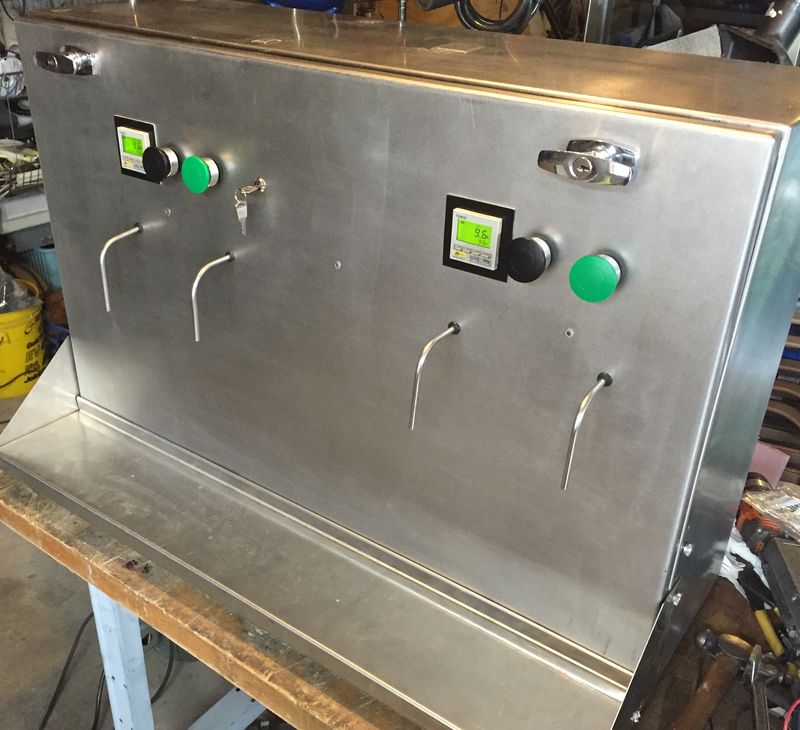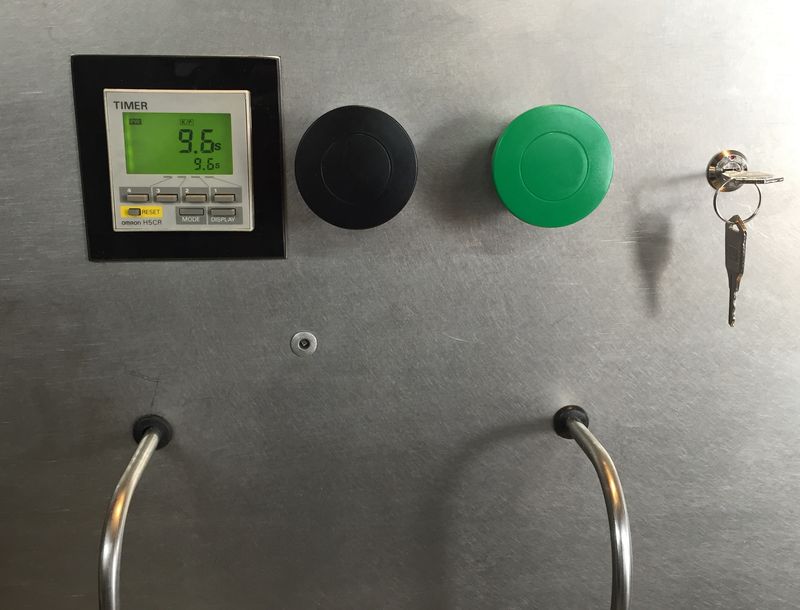
Welcome!
Be part of our community & join our international next generation forum now!
Categories
In this Discussion
- blackdiamond December 2017
- CothermanDistilling May 2017
- crozdog May 2017
- EZiTasting May 2017
- FloridaCracker August 2016
- grim December 2017
- HadlerDistillations May 2017
- jacksonbrown September 2016
- Kapea September 2016
- punkin May 2017
- richard May 2017
- RobertS May 2017
- Telluride May 2017
- Unsensibel August 2016




Comments
Omron H5CR Digital Timers - One per bank. Each timer controls a high precision teflon solenoid.
Left bank and right bank are independent, and have a separate timer and solenoid for the two filler nozzles - this is for calibration purposes.
Since there is only a single pump, and we wanted both banks to run independently, operation of each bank will disable the start of the opposite bank.
This is to provide the ability to load and fill two bottles, while unloading and removing the opposite bank. There is no downtime. Since the operator has (usually) two hands, it makes sense to run two bottles.
Need to re-calibrate timing, since we changed the internal tube work, but it's relatively fast per bank.
Uses the same diaphragm pump that the Xpressfill units use.
The key lock is will lock-out settings changes on the digital timers, this is to prevent accidental settings changes.
Green - Start, Black - Emergency Stop
My pops outdone himself with this build. The interior is spectacular.
Very cool. Would love to see behind the panel
It sure is pretty!
I'm more like I am now than I was before.
You just pulled the curtain back on, well.........forget it...
I'd love a look under the hood too if your old man doesn't mind.
So is the principle a PD pump on a timer?
Do you count cycles or just run time?
How big is the pump (volume per rev)?
Do you need to do any temp adjustments?
Are there breathers for each nozzle behind the panel ?
Pump is modulated based on a pressure switch. When solenoid is open, the pump is pumping, when the solenoid shuts, the pump shuts nearly immediately. The pressure switch is 30psi. This is integral to the pump.
The timers are only connected to the solenoids, they don't care about the pump.
The pump is a Flojet beverage pump with the appropriate seals for high alcohol. This required me to buy the pump, and swap the diaphragm kit. It's not hard.
The pump is 85ml per second, but that's the free flow spec. You lose flow rate through the plumbing, solenoids, and nozzles, pick up tube. Two bottles fill in about 21-22 seconds.
Volumetric fillers absolutely need to be set by weight each time to be very accurate. If you don't care about fill accuracy, then don't bother. Weight is more accurate than volume to calibrate.
No no no breathers behind the nozzles. The nozzle tubes do not drain more than a drop or two. They are relatively narrow, 1/4" OD stainless. The nozzles go straight back to the solenoids.
Excellent. Thanks for posting.
Solenoids are Furon DV2 or DVX, can't remember.
So the split between the two bottles is relying on even pipe work?
Yep.
You could add needle valves to precisely balance. Or use a short and long leg, and add a valve to the short leg.
There is a stainless branch tee on the blind side of the solenoid that the piping attaches to.
Props on the fab work. Very nice
supposedly my xpressfill uses 'ruby orifices'.. impervious to change... but they ain't perfect..
Sounds like a pr0n0
Volumetric fill ain't perfect, level fill ain't perfect. We know what's perfect, do it by weight into bottles with an impeccable tolerance, but that's a whole 'nother issue.
You do bring up a good point, and it's real (see all the way at the bottom). But, you can buy standardized orifice and swage them, or press fit, in the tube, they aren't expensive, although sourcing might take a couple of hours.
But that doesn't change the fact that the volume will differ based on the temperature of the liquid, and the atmospheric pressure. Which means even given a standardized orifice, you'd still need to correct across extremes. Bottling a chill filtered spirit that is sitting at 60f is going to be different from bottling from a tank at 84f (it's a hot day). Likewise, bottling during a hurricane going to require different settings from a cold dry winter day.
Not to mention the elephant in the room, the diaphragm pump stroke. Even with super precision timers like the Omron and others (which are accurate to .01 second), the problem is that you can only be accurate (really) to a diaphragm stroke, depending on where the stroke starts/stops, and the flapper position, all that jazz.
I did consider using a Cole Parmer lab metering diaphragm pump. They have a system that has feedback on the specific stroke, so you dial in the exact number of pump strokes needed to get to your dispensing volume. It dispenses the exact number of strokes every time. This would be much more accurate, as plumbing and orifice details are irrelevant.
(Last note - when you use rotating pipe cutter, you actually make an orifice smaller than the pipe diameter - you do actually need to true the pipe diameters or you'll get fill variation).
For tuning you could just crush the tube a tiny bit (behind the curtain).
I was going to ask about counting strokes. It might not actually be a that hard to test.
You might be able to add a hall effect sensor and mag to the shaft very easily.
Hooked up to a counter you could run what you have and see how constant the stroke count is for the time method, also if over or under fills can be seen in stroke count discrepancies.
I was thinking this is how I would approach it but figured if the added complexity was worth the effort, you probably would have done it.
Does the stroke volume change much with varying feed pressure?
At the pump inlet? You mean due to the level in the filling tank?
O'Keefe in CT makes a tube insertion orifice, only problem is the max orifice size is 1/16th.
Great, but the filler would turn into a pressure washer with a 30psi pump behind it.
Or, just use a solenoid on each nozzle, connected to it's own dedicated timer.
This way you can tune/calibrate each nozzle independently. You can trigger them all to start at the same time, or not.
Cotherman - do you know how many solenoids the Xpressfill units use? I believe it's only 1 for either the 2 or 4 head.
We went with 2 solenoids and 2 timers to give us a little more accuracy, plus the ability to run the unit with only 2 bottles at a time (I think this is actually faster in terms of actual bottles per hour).
For someone on the hobby side, DIY - just do a single head.
@grim on the hobby side - use a funnel and a bottle on a scale ;-)
There are plenty of diy geeks that would do it for the hell of it. You don't need controllers either.. :)
There's truth to that (me not excluded).
Yep, is an intermediate balance tank needed?
Highly accurate laboratory pipettes use a cylnder and piston to draw and dispense a desired volume of liquid (true volumetric measurement).
That would seem to be an easy way to fill bottles, well within the TTB tolerance. No one makes a filler based on this concept?
I'm more like I am now than I was before.
I can't imagine a balance tank is necessary with a displacement pump. I mean, if you had some extreme swing in head pressures, the diaphragm and seals are flexible, so you might have some variation, but I can't imagine significant.
Heck, it seems to pump consistently in either suction or with positive inlet pressure.
Piston fillers? They are out there, but they are usually only used for high viscosity products. They tend to be expensive and slow.
Fill tolerance on a 750ml is +-2%.
That's 735-765ml, you need an even distribution of over and underfill, but that's huge.
I looked at them, then just forked out the $2700... could I make one cheaper, yes... but I have other stuff to work on, and this came with a statement of accuracy of 10 fills in a row of each 375 and 750ml and how much each spout deviated (1ml was the max deviation).. when I can eliminate a concern 100% for a fixed price, I tend to take it...
Actually used the piston one in my high school years at a put supply store where we cut up and ground up condemned beef and mixed with organ meat and pressed and used the piston filler to fill 1lb and 5lb bags of fresh dog and cat food... it was placed in a big pressure vessel that had bottom that came up with air pressure to force the ground meat out. a 1000lb sausage stuffer..
With lower viscosity spirits I think the cycle time would be faster. With two parallel cylinders per bottle port, one cylinder fills while the other dispenses. Adjustment to the piston stroke would allow you to dial in accuracy, and/or set fill volumes for different bottle sizes. Fixed, premeasured volumes remove pump pressures and valve times from the equation.
This is old school technology. Seems like it would be an easy fab.
I'm more like I am now than I was before.
I've used them before. They came from Italy and were very expensive.
I think it was a lecithin dosing unit.